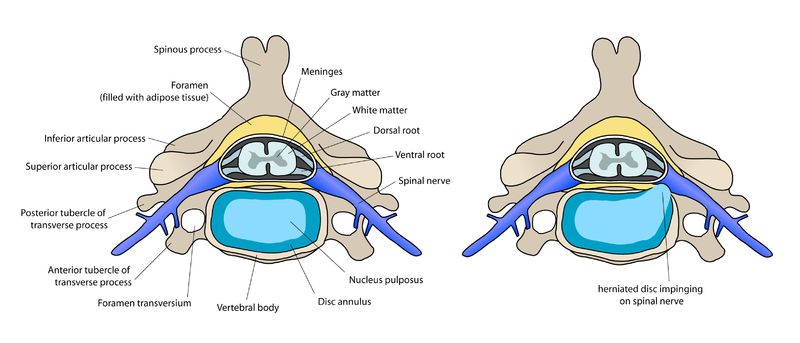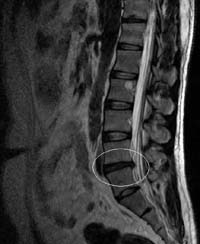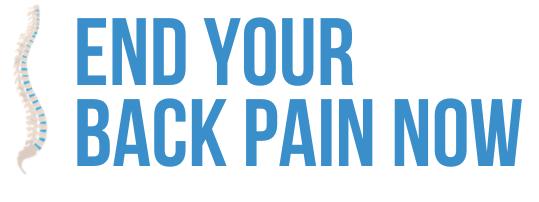A disc herniation is a condition that affects the spine in which a tear in the outer fibrous ring of a spinal disc allows the soft central portion to bulge out. But disc herniation is the progression of a previously existing disc protrusion, a situation in which the outermost layers of the annulus fibrosis are still intact, but can bulge when the disc is under pressure.

The disc is a section that lies in between each of the bones of your back. Problems can occur when part of the disk either bulges or moves out of its usual space. It either presses on or comes close to nerves that go down your legs. Pain can possibly result in some cases even if the disk is not actually compressing the nerve but only comes close in proximity.
Disc bulges can occur in one of two different ways:
1. A bulge occurs when the fluid inside a disc is displaced. Bulging discs usually don’t cause any symptoms, because they may not be pressing on the nerve roots as they exit the spine.
2. A herniation occurs when the fluid inside a disc bulges toward the back of your body and breaks through the disc wall’s outer ring, called the annulus fibrosis.
What is interesting to note is that many disc bulges come and go, usually even without treatment, and sometimes can resolve within 4-6 months. Disc herniations, however, can be a significant source of lower back pain, due to the fact that when the bulge compresses on a nerve root as it exits the spine, it can create pain down your butt, hips, and legs, and usually requires treatment of some sort to resolve.
What Causes Disc Herniations?
Disc bulges and herniations are less common with individuals under the age of 30, due to the fact that the disc contains much more fluid and elasticity. As we age, we lose the elasticity in these discs. Most disc herniations occur when a person is in their 30s or 40s, when the nucleus pulposus (the center of the spinal disc) is still a gelatin-like substance. After about age 50, the discs become harder and less elastic, and contain less fluid, therefore becoming less frequently herniated.
Disc herniations can occur from general wear and tear, jobs or acquire constant sitting over long periods of time, and can be the result of long-term muscle imbalances. Lumbar disc herniation occurs 15 times more than the cervical and thoracic portions of the spine.
More often than not, poor postural alignment is usually present with this condition. A flat lumbar spine (measuring less than 30 degrees), combined with a posterior pelvic tilt are usually characteristic.
Maintaining this “office worker” posture over time, causes increased disc pressure, particularly since sitting puts the MOST pressure on spinal discs, especially when there is a rounded back posture, as with “hunching over” at a computer for 8 hours per day!
It is also thought that long term dehydration, may be a contributing factor for spinal disc problems. There may be some truth to this, considering the fact that the majority of the fluid in the disc is WATER! In fact, the nucleus is a soft water attracting substance, comprising up to 25% of the total disc area!
Herniated Disc Symptoms
Spinal disc herniation symptoms can be a little tricky, so you need to be able to accurately describe your symptoms in order to figure out if a disc herniation is causing your pain or not. I mention this because frequently, most medical doctors use visual diagnostics such as MRI’s, X-rays, and sometimes CT scans to diagnose back pain conditions.
This can be VERY mis-leading, considering the fact that both back pain sufferers, and those with NO back pain may have abnormalities show up on these tests. It is important to correlate your symptoms with the findings on the test reports in order to arrive at an accurate diagnosis.

Symptoms of a Bulging or Herniated Disc may include:
1. Numbness or tingling going down your butt, hips, legs or feet
2. Sharp or shooting pain referring down your butt, hips, legs or feet
3. Pain upon flexing your spine (bending forward with a rounded lower back). This may reproduce symptoms with a posterior disc bulge.
4. Pain that is worse in the morning, but then gets better as the day goes on. (This is because your spinal discs are MOST hydrated in the morning, and due to this, can be pressing more on the nerve root).
5. More pain in sitting position than in standing. (Sitting increases disc pressure dramatically more than standing).
Disc Herniation Treatments
Most people get better within 2 to 3 months of conservative treatment. The great majority of disc herniations can be treated using nonsurgical, conservative management such as combination of corrective exercises and stretches for muscular imbalance, spinal manipulation techniques, and time.
Most treatments for disc herniations are surgically based, however, there are some natural correction techniques that can help you avoid the potential pitfalls of surgical intervention.
Herniated Disc Exercises and Stretches:
Corrective exercises and stretches, and physical therapy for a herniated disc should not be prescribed haphazardly. Due to the fact that spinal flexion aggravates MOST disc bulges, corrective exercises should target the muscles that extend your spine, thus contributing to anterior pelvic tilt, OR focus on strengthening your spine and pelvis into the “neutral” position. Corrective stretches should target the muscles that create flexion in your spine, as well as posterior pelvic tilt.
There is plenty of evidence showing that movement can be effective for treating disc problems. A program that emphasized skill-based exercise therapy for the spine effectively treated the affected lumbar discs (Saal and Saal 1989) and rehabilitated football players with back injury (Saal 1988). The program aimed to restore automatic control of muscular stabilization of the trunk by teaching subjects to maintain a correct lumbar pelvic position while performing progressively more complex tasks.
You DEFINITELY need to know what you are doing when performing exercises when you have a herniated disc or bulge. Exercises that axially load the spine, reduce a person’s height through discal compression — squat exercises and weight training, for example, can create compression loads in the L3 L4 segment of 6 to 10 times body weight (Cappozzo et al. 1985). Clearly, exercises that involve this degree of spinal loading or unsuitable for individuals with discal pathology.
Mckenzie Extension Protocol:
Renowned physical therapist Robin Mckenzie has a fabulous program for the assessment and treatment of “spinal derangements”. This includes disc bulges. I have personally recommended this approach for individuals with active disc bulges, and feel that is it consistently works over other approaches.
